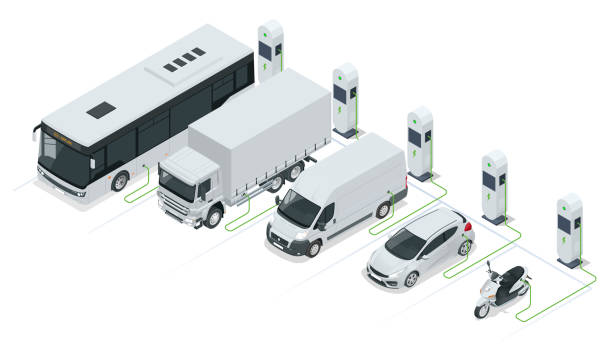What is EV fleet charging?
EV fleet charging is a system designed to power electric vehicles (EVs) used by logistics and fleet operators. It goes beyond plugging into a standard outlet at home. Instead, it utilizes designated charging stations at multiple locations, significantly reducing charging times. These stations can be installed centrally at depots (hubs for fleet vehicles) or distributed throughout your operating area for maximum convenience. The system typically uses Level 2 chargers, offering faster charging compared to standard outlets, ensuring your vehicles spend less time tethered and more time completing deliveries or transporting goods.
What are the key benefits of implementing EV fleet charging?
o Enhanced Operational Efficiency: Faster charging times compared to standard outlets translate to less downtime for your vehicles. This translates to maximized productivity as your fleet spends more time on the road completing tasks.
o Data-Driven Cost Management: EV fleet charging systems often come with built-in monitoring capabilities. You can track energy consumption and charging costs per vehicle. This valuable data allows you to make informed decisions regarding fleet operations and energy usage, potentially leading to cost savings.
o Scalable Infrastructure: As your fleet grows, your charging infrastructure can easily adapt. You can expand by adding more charging stations at existing locations or establishing new charging points throughout your operating area. Additionally, some systems allow for increased capacity at existing stations, ensuring your charging capabilities keep pace with your fleet’s needs.
o Sustainable Practices: Transitioning to EVs significantly reduces greenhouse gas emissions compared to traditional gasoline or diesel vehicles. By implementing EV fleet charging, you contribute to a cleaner environment and demonstrate your commitment to sustainable business practices.
What are the different types of EV chargers for logistics and fleet operators?
The optimal charger type depends on the specific demands of your fleet. Here’s a breakdown of the most common options:
o Level 1 Chargers (Slowest): These chargers provide the slowest charging rate and are best suited for overnight charging of light-duty vehicles with minimal daily mileage requirements.
o Level 2 Chargers (Faster): Offering a significant increase in charging speed compared to Level 1, these chargers are ideal for medium-duty delivery trucks or vans that require quicker turnaround times between routes.
o DC Fast Chargers (Fastest): Delivering the fastest charging speeds among all options, DC fast chargers utilize high voltage levels to provide up to 80% charge in under an hour. This makes them perfect for heavy-duty commercial trucks that complete long-distance journeys daily.
How to choose the perfect EV charging for a fleet?
Choosing the right charger requires careful consideration of several factors:
o Vehicle Types: Match the charging speed to the daily mileage requirements of your vehicles. For example, heavy-duty trucks with long routes benefit from DC fast chargers, while light-duty vehicles with shorter commutes may function well with Level 2 options.
o Fleet Size and Growth: Consider the current size of your fleet and anticipate future expansion when selecting your charging infrastructure. Planning for future growth ensures your charging capacity adapts alongside your business.
o Budget: Balance the initial costs of acquiring and installing chargers with the long-term operational expenses associated with energy consumption. Consulting with an EV infrastructure expert can help you find a budget-friendly solution that optimizes both cost and efficiency.
How to implement EV fleet charging in a sustainable way?
By implementing a well-designed EV fleet charging solution, you can significantly improve your fleet’s operational efficiency, reduce environmental impact, and position your business at the forefront of sustainable transportation practices. Evaluating your specific needs and consulting with EV infrastructure experts will ensure you select the most cost-effective and efficient solution. Here are some additional tips for a sustainable approach:
o Explore Renewable Energy Sources: Investigate integrating renewable energy sources like solar panels into your charging infrastructure. This can further reduce your reliance on traditional energy sources and contribute to a cleaner overall operation.
o Implement Smart Charging Practices: Utilize features like scheduled charging during off-peak hours when electricity rates are lower. This can help optimize energy use and potentially lead to cost savings.




